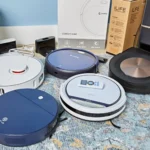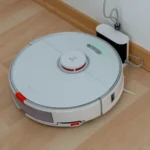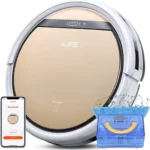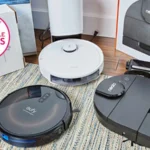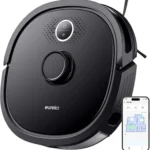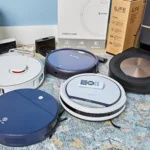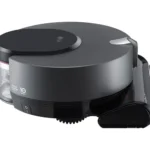Imagine this scenario: you’ve just invested in a smart vacuum cleaner that boasts all the latest features – app connectivity, voice control, ultra-powerful motor – only to have it die on you midway through your cleaning session. Frustrating, isn’t it? The culprit? An unsuitable battery type or capacity. As mundane as it sounds, the battery is a crucial component in any smart vacuum cleaner, influencing everything from its performance and runtime to its maintenance and replacement. In this article, we’ll delve into the world of smart vacuum cleaners and explore the importance of battery type and capacity, factors to consider when choosing a battery, and tips for maintenance and replacement. So, grab a cup of coffee and let’s dive in!
The Role of Battery Type and Capacity in Smart Vacuum Cleaners
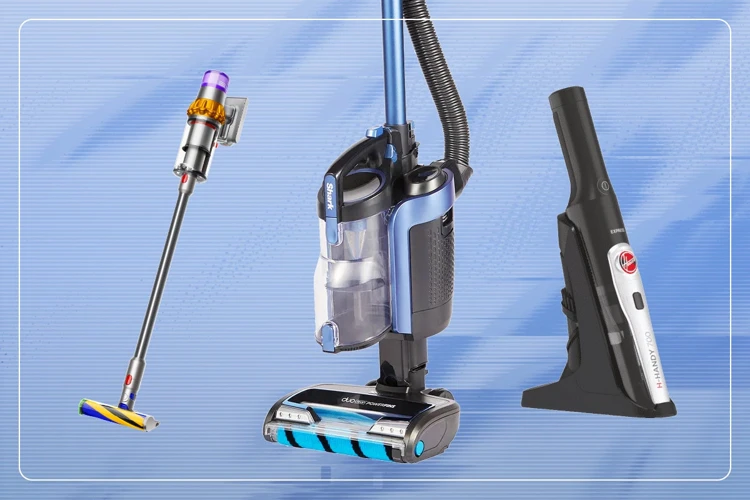
The battery type and capacity of a smart vacuum cleaner play a significant role in determining the device’s overall performance and efficiency. The battery is the powerhouse that enables the vacuum cleaner to function and maneuver around your home, delivering a thorough cleaning experience. It is essential to understand the differences in battery types, capacity, and how they impact the smart vacuum cleaner’s features and overall cleaning experience. This knowledge will help you make an informed decision when choosing the right battery type and capacity that meets your needs. In the following sections, we’ll explore more deeply the importance of battery life, charging time, and influence on other features of smart vacuums. We’ll also look at the critical factors to consider when choosing the right battery capacity and type for your home. Finally, we’ll discuss battery maintenance and replacement to ensure that you get the most out of your investment. To learn more about how the design of smart vacuums affects their efficiency, check out our article on designing smart vacuums for efficiency.
1. How battery types differ
Smart vacuum cleaners are handy gadgets that help keep homes clean and fresh without much human intervention. Their battery type and capacity play a critical role in determining their performance and capabilities. Different battery types have varying energy densities, discharge rates, and other performance characteristics that can significantly affect the efficiency of the smart vacuum cleaner.
Table 1: Comparison of common battery types for smart vacuum cleaners
| Battery Type | Pros | Cons |
|---|---|---|
| Lithium-Ion (Li-Ion) | High energy density, long cycle life, no memory effect, low self-discharge rate | Expensive, discontinues performance after a few years, extreme temperature sensitivity |
| Nickel-Metal Hydride (NiMH) | Low-cost, readily available, environmental friendly, good cycle life, can be used in any orientation | Low energy density, heavy, prone to memory effects and self-discharge, shorter lifespan and run time |
| Nickel-Cadmium (NiCd) | Relatively low-cost, long cycle life, rugged, withstands temperature extremes and vibration, can be charged rapidly | Heavy, long charging time, prone to memory effect, finite lifespan, and run time, environmentally hazardous |
| Lead Acid (Pb-acid) | Low-cost, high durability, large capacity, ideal for high drain applications, can be reconditioned | Heavy, big in size, venting required, short lifespan and cycle life, susceptible to over-discharging when used deeply |
As depicted in Table 1, each battery type has its advantages and disadvantages, and the type you choose boils down to your needs, budget, and preferences. For smart vacuum cleaners, Lithium-Ion batteries reign supreme because of their high energy density and long cycle life. They can deliver strong, sustained power throughout their life cycle, pack more power into a smaller and lighter package than other batteries, and are environmentally friendly.
However, Li-Ion batteries can be sensitive to extreme temperatures, which affect their performance and lifespan. They also tend to be more expensive than other batteries, and their performance decreases after a few years of use. Nickel-Metal Hydride batteries are another popular choice for smart vacuum cleaners due to their low cost and environmental friendliness. Still, they have lower energy density, shorter lifespan, and are prone to memory effects, among other issues.
NiMH and NiCd batteries are widely used in older models and entry-level smart vacuum cleaners but are slowly losing traction to Lithium-Ion batteries. Lead-Acid batteries, although durable and long-lasting, are too large and heavy for smart vacuum cleaners and are mainly used in heavy-duty applications.
Interested in learning more about the lifespan and maintenance of smart vacuum cleaner batteries? Check out this article.
2. How capacity influences performance
One of the most crucial factors when it comes to the performance of smart vacuum cleaners is battery capacity. The capacity of a battery directly influences the run time and suction power of the device. The higher the battery capacity, the more powerful and performance-oriented the smart vacuum cleaner will be.
In simpler terms, battery capacity refers to the amount of energy that the battery can store. This energy is then used to power the motor, which runs the robot’s suction and cleaning abilities. A battery with a higher capacity will deliver more power to the motor, resulting in better performance.
Let us take a closer look at how capacity influences the performance of smart vacuum cleaners.
Table: Capacity vs. Performance
| Battery Capacity | Performance |
|---|---|
| Less than 2000mAh | Poor suction power, less run time |
| 2000mAh-3000mAh | Decent suction power, moderate run time |
| 3000mAh-4000mAh | Good suction power, longer run time |
| Above 4000mAh | Excellent suction power, longest run time |
As evident from the table above, battery capacity plays a significant role in the performance of a smart vacuum cleaner. A battery with less than 2000mAh capacity will provide poor suction power and less run time. This means that the device will not be able to remove dirt and debris efficiently, and the battery will need to be recharged frequently.
A battery with a capacity in the range of 2000mAh to 3000mAh will provide decent suction power and moderate run time. However, it may not be suitable for larger homes or areas with more significant dirt and debris accumulation.
A battery with a capacity in the range of 3000mAh to 4000mAh is an ideal choice for a smart vacuum cleaner. This battery will provide good suction power and longer run time, allowing the device to clean efficiently without the need for frequent recharging.
For those who require the most exceptional performance and run time, a battery with a capacity above 4000mAh is the best option. This battery will deliver excellent suction power and the longest run time, making it ideal for larger homes or areas with high dirt and debris accumulation.
To ensure optimal performance and an extended lifespan of the smart vacuum cleaner’s battery, it is crucial to maintain and replace it periodically. For more information on battery life and maintenance tips, you can check out our article on smart vacuum battery life, comparison of smart vacuum battery life, and tips to extend smart vacuum battery life.
3. Battery life and charging time
One of the biggest considerations when it comes to selecting the right battery type and capacity for a smart vacuum cleaner is the battery life and charging time. This is an important factor that will determine how effective and efficient your smart vacuum cleaner will be at cleaning your home.
Battery life: The battery life of a smart vacuum cleaner can vary greatly depending on various factors such as the type of battery used, the capacity of the battery, the brand and model of the vacuum cleaner, and the intensity of usage. Some vacuum cleaners have a battery life of only 30 minutes, while others can last up to 120 minutes or even longer. It’s important to check the battery life of a smart vacuum cleaner before purchasing it.
Charging time: Another important factor to consider when it comes to battery type and capacity is the charging time. No one wants to wait for hours to charge their smart vacuum cleaner, especially if they have to clean the house on a regular basis. Charging times can vary significantly, ranging from a few hours to over 5 hours.
To help you make an informed decision, here is a table outlining the battery life and charging time of some popular smart vacuum cleaners:
| Model | Battery life | Charging time |
|---|---|---|
| Xiaomi Mi Robot Vacuum | 150 minutes | 240 minutes |
| iRobot Roomba 671 | 90 minutes | 120 minutes |
| Dyson V10 Absolute | 60 minutes | 210 minutes |
| Eufy RoboVac 30C | 100 minutes | 300 minutes |
When considering battery life and charging time, it’s important to keep in mind that the higher the capacity of the battery, the longer the battery life will be. However, this can also increase the charging time. It’s important to strike a balance between battery life, charging time, and capacity to ensure optimal performance and efficiency.
4. How battery influences features
The battery type and capacity in a smart vacuum cleaner not only affect its performance but also its features. Different batteries have different characteristics that determine the functionalities of the vacuum cleaner.
Let’s take a closer look at the features that the battery can influence:
| Features | Battery Type |
|---|---|
| Suction Power: | Some battery types can deliver more power to the motor, boosting the suction power of the vacuum cleaner. For example, lithium-ion batteries provide higher voltage output and better discharge efficiency, resulting in more suction power. |
| Runtime: | The capacity of the battery directly affects the runtime of the vacuum cleaner. A higher capacity battery provides longer cleaning time between charges. For instance, a vacuum cleaner with a 2600mAh battery can clean for up to 100 minutes, while a vacuum cleaner with a 5200mAh battery can clean for up to 200 minutes. |
| Digital Connectivity: | Some smart vacuum cleaners model can connect to a home Wi-Fi network and be controlled by a smartphone application. The type of battery can influence the connectivity feature. For example, manufacturers may use a lithium-ion battery to power a vacuum cleaner’s Wi-Fi receiver, the vacuum will be able to communicate for much longer periods compared to nickel-based alternatives as they are less susceptible to voltage drops that may affect Wi-Fi reception. |
| Charging Speed: | Different battery types have varying charging times, which can determine how much time it takes to prepare a vacuum cleaner for the next cleaning session. A vacuum cleaner equipped with a lithium-ion battery, for example, tends to have a shorter charging time compared to a vacuum cleaner with a nickel-based battery. Manufacturers may also have charging features that optimize the battery life. For instance, some vacuum cleaners have a self-charging feature that allows the device to stop charging once it is fully charged, preventing battery overcharging and prolonging the life of the battery. |
| Weight: | The type of battery can also affect the weight of the vacuum cleaner. Lithium-ion batteries are known to be lighter compared to nickel-based batteries. The weight of the battery directly impacts the overall weight of the vacuum cleaner, making it either easier or more challenging to move around during cleaning. The lightweight vacuum cleaners powered by a lithium-ion battery can be useful for people with mobility challenges. |
When choosing a smart vacuum cleaner, it’s essential to consider the features that are affected by battery type and capacity. You should consider the cleaning tasks and features that you require, such as suction power or digital connectivity, when picking a battery type that suits your specific needs.
5. Compatibility with smart features
Smart home technology has taken the world by storm, and smart vacuum cleaners are no exception. These robotic cleaners often come with a range of convenient features that allow homeowners to clean their house even when they’re away. However, it’s important to ensure that the battery type and capacity of your vacuum cleaner are compatible with its smart features.
One important aspect to consider is the compatibility of the battery with the mobile app or smart assistant that controls the vacuum cleaner. Some vacuum cleaners may only work with specific mobile apps or smart home hubs, while others may only work with certain voice assistants like Amazon Alexa or Google Assistant. It’s important to make sure that the battery type and capacity are compatible with these features to ensure that the vacuum cleaner can be controlled remotely.
Another important factor to consider is the runtime of your vacuum cleaner. Smart vacuums that come with scheduling features must have sufficient battery life to run for the duration of cleaning cycles. For instance, if you’re planning to schedule your vacuum cleaner to run for a few hours, you must ensure that the battery capacity can handle that runtime. You may also need to consider whether you live in an area with frequent power outages, in which case you’ll need to ensure that your vacuum cleaner is equipped with a battery backup to avoid losing scheduled cleaning cycles.
Finally, it’s important to keep in mind any additional features that may require battery power, such as a mapping feature that allows the vacuum cleaner to create a floor plan of your home. This requires the battery to have ample capacity and longevity to perform these complex tasks. In some cases, you may need to prioritize performance and runtime over battery lifespan to ensure that you’re able to use these features effectively.
Compatibility with smart features is an important consideration when choosing a battery type and capacity for your smart vacuum cleaner. The following table outlines some of the key compatibility factors you should consider when choosing your vacuum cleaner’s battery:
| Compatibility Factor | Importance | Considerations |
|---|---|---|
| Smart assistant compatibility | High | Verify that the vacuum cleaner is compatible with your preferred voice assistant or smart home hub |
| Mobile app compatibility | High | Ensure that the vacuum cleaner can be controlled via your smartphone or tablet and that the necessary app is available for your device. |
| Battery runtime | High | Make sure that the battery has enough capacity to handle the desired runtime for scheduled cleaning cycles or other tasks |
| Battery backup | Medium | Consider whether a battery backup feature is necessary to ensure that scheduled cleaning cycles remain uninterrupted during power outages. |
| Additional feature support | Medium | Ensure that the battery has enough capacity and longevity for additional features like mapping, room identifiers, or remote control. |
With a better understanding of your vacuum cleaner’s compatibility with smart features and the factors to consider when choosing battery type and capacity, you can select a vacuum cleaner that offers the convenience and performance you need while also meeting your battery requirements.
Factors to Consider When Choosing Battery Type and Capacity
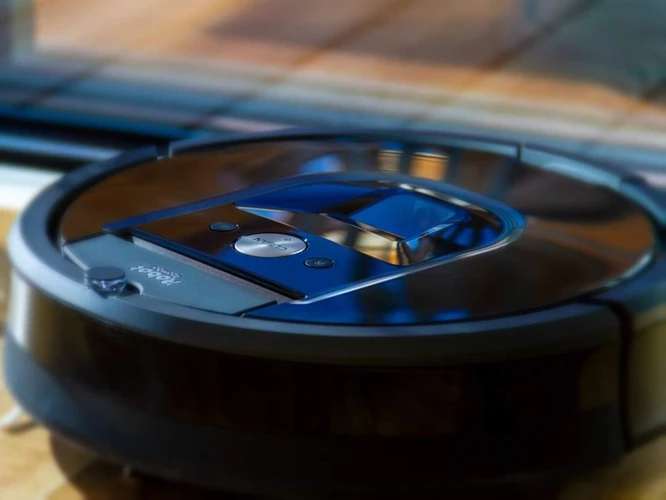
When it comes to choosing the right battery type and capacity for your smart vacuum cleaner, there are a variety of factors that you need to take into account, and it can be overwhelming to navigate through all the available options. However, by considering certain important factors, you can narrow down your choices and make an informed decision that will ensure the best performance and longevity for your device. In this section, we’ll explore some crucial aspects that you should consider before making a purchase and discuss how they can impact the overall quality of your cleaning experience.
1. Type of cleaning tasks
When considering the importance of battery type and capacity in smart vacuum cleaners, one of the key factors to consider is the type of cleaning tasks you expect the vacuum cleaner to perform. Different cleaning tasks require different levels of suction power and runtime, which are both closely linked to the battery type and capacity.
Table:
| Type of cleaning task | Battery Type | Battery Capacity |
|---|---|---|
| Pet hair | Lithium-Ion | 3000 mAh or more |
| Carpet | Nickel-Metal Hydride (NiMH) | 2000 mAh or more |
| Hardwood floors | Lithium-Ion | 2000 mAh or more |
| Large debris | Lithium-Ion | 3000 mAh or more |
Pet hair: If you have pets, you’ll want to choose a smart vacuum cleaner with a lithium-ion battery and a capacity of 3000 mAh or more. This will ensure that your vacuum cleaner has the power to pick up pet hair and dander efficiently, without running out of power in the middle of a cleaning cycle.
Carpet: For carpets, nickel-metal hydride (NiMH) batteries are a good choice. These batteries have a lower capacity than lithium-ion batteries but are still powerful enough to provide excellent suction on medium-pile carpets. A capacity of 2000 mAh or more should be sufficient for most households.
Hardwood floors: If you have hardwood floors, you’ll want to choose a smart vacuum cleaner with a lithium-ion battery and a capacity of 2000 mAh or more. This will provide enough power for the vacuum to pick up dirt, dust, and small debris without scratching your floors.
Large debris: For large debris, such as cereal or leaves, a lithium-ion battery with a capacity of 3000 mAh or more is recommended. This will ensure that the vacuum cleaner has enough power to pick up all the debris without losing suction or battery life.
By considering the type of cleaning tasks you’ll need your vacuum cleaner for, you can choose a battery type and capacity that is best suited for your needs. This will help ensure that your smart vacuum cleaner can provide the suction power and runtime you need to keep your home clean.
2. Type of flooring
When choosing the battery type and capacity for a smart vacuum cleaner, the type of flooring in your home is an important factor to consider. Not all batteries are created equal, and different types of flooring can have varying power needs. Here are some flooring types to consider and the battery capacity they may require:
- Hardwood or Tile Floors: These types of floors are generally easy to clean, requiring less suction power. However, they can still accumulate debris over time, so it’s important to use a vacuum with adequate battery capacity to cover the entire floor without needing frequent charging.
- Carpet Floors: Carpeting can trap dust, dirt and other allergens deep within its fibers, so a vacuum with stronger suction power may be required. This translates to a higher battery capacity so that the vacuum can do its job without running out of power quickly, causing interruptions in the cleaning process.
- Area Rugs: These typically require less suction power than carpet flooring, but still may require a vacuum with extra battery capacity, especially if they are thick or have a lot of textured elements to them.
- Stairs and Upholstery: When vacuuming stairs or upholstered furniture, you’ll want a lighter, more compact vacuum that can easily maneuver in tight spaces. A device with adequate battery capacity ensures you can thoroughly clean everything without running out of power part way through.
When considering the type of flooring in your home when shopping for a smart vacuum cleaner, it is important to remember that a higher battery capacity typically means a longer run time, and this will often account for the biggest difference in battery life between devices. If you have a large home or extensive flooring, it may be wise to invest in a model with a larger battery life so you won’t have to stop and recharge mid-way through cleaning sessions.
3. Home size and layout
The size and layout of your home are important factors to consider when choosing the battery type and capacity of your smart vacuum cleaner. Here are some specific things to keep in mind:
- Area of your home: A larger home will require a vacuum with a higher battery capacity to cover the entire area without running out of power. On the other hand, a smaller home may not require as much battery capacity, which can save you money in the long run.
- Floor plan: The layout of your home can also affect the type of vacuum you need. If your home has a lot of tight spaces, such as narrow hallways, small rooms, or multiple levels, a vacuum with a slim design and long battery life may be more suitable to navigate around obstacles.
- Type of flooring: Homes with mostly carpets or rugs will require higher suction power and longer battery life than those with hard flooring. On the other hand, if your home has mostly hard surfaces, a vacuum with a lower suction power and battery capacity may be appropriate.
- Stairs: If your home has stairs, you may need to consider a vacuum that is lightweight and has a detachable handheld component, which can make it easier to carry up and down stairs.
By taking into account the specific needs and features of your home, you can select a smart vacuum cleaner with the battery type and capacity that suits your requirements. This will ensure that you get the most efficient and effective cleaning experience without interruption.
4. Charging availability
One crucial factor to consider when choosing the battery type and capacity for your smart vacuum cleaner is the availability of charging. This is an essential factor because it determines the convenience and efficiency of using your device. Without proper charging, your smart vacuum cleaner will be rendered ineffective, causing you supply of clean floors to be halted.
Here are some key charging availability factors to keep in mind when choosing your device:
| Factors | Importance |
|---|---|
| Charging Time | The amount of time the battery takes to charge is a crucial factor. Some batteries take longer to charge than others, which could cause inconvenience and reduce the efficiency of the device usage. A device with a higher battery capacity will take longer to charge than a device with a lower battery capacity. |
| Wall Outlet Access | Consider whether you have ample access to wall outlets. If your home has only a limited number of electrical outlets, it is essential to make sure your vacuum cleaner charging station or charger can be located in a convenient location. |
| Portability | The ability of the device to be moved from room to room is vital. If the device only works within a stationary charging station, it may not be as useful when moving throughout your home. You must determine whether you need a portable device with a charging dock or a corded device that doesn’t require charging. |
| Backup Battery | Consider the availability of a backup battery. If your smart vacuum cleaner requires a lot of power to run, it may be prudent to invest in a backup battery to ensure that the device never runs out of juice while cleaning. Backup batteries also offer greater mobility and flexibility, allowing you to swap out batteries as needed. |
Ultimately, the charging availability of the device depends on how effectively the smart vacuum cleaner can access power. By keeping these factors in mind, you can select the ideal device that suits your specific requirements, and that would ensure you never run out of battery while cleaning.
Battery Maintenance and Replacement
As with any other appliance, proper maintenance is crucial to ensure your smart vacuum cleaner lasts for years. Battery maintenance and replacement are especially important, as the battery is the heart of your vacuum’s performance. You don’t want to be left with a poorly-performing vacuum, or worse, no vacuum at all, due to neglecting your battery. In this section, we will discuss essential battery maintenance tips and when to consider replacing your vacuum’s battery. So, let’s dive into the details and keep your vacuum running like new!
1. Battery lifespan and replacement
The lifespan of the battery in a smart vacuum cleaner is a critical factor to consider when choosing the right one for your home. Not only does it affect the performance and efficiency of the vacuum, but it also impacts the cost-effectiveness of the device. Here are some important things to keep in mind when it comes to battery lifespan and replacement:
Battery lifespan: The typical lifespan of a smart vacuum cleaner battery can vary depending on the brand and model, as well as the frequency of use. On average, most batteries can last for around 2-3 years before they start to lose their capacity significantly. However, some high-quality batteries can last for up to 5 years or more.
Battery replacement: When your smart vacuum cleaner battery reaches the end of its lifespan, you’ll need to replace it to keep the device working efficiently. The cost of a replacement battery can vary based on the brand and model of the device, with some batteries costing as little as $30, while others can cost up to $200 or more.
To help you choose the right replacement battery for your smart vacuum cleaner, here’s a table that shows the battery life and replacement cost for some of the most popular brands and models on the market:
| Brand/Model | Battery Life | Replacement Cost |
|---|---|---|
| Dyson Cyclone V10 Absolute | 60 minutes | $90 |
| iRobot Roomba 980 | 120 minutes | $80 |
| Shark ION R85 | 80 minutes | $60 |
| Xiaomi Roborock S6 MaxV | 180 minutes | $120 |
Battery maintenance: To maximize the lifespan of your smart vacuum cleaner battery, there are some maintenance tips that you should follow. First, avoid exposing the battery to extreme temperatures, which can damage the cells and reduce its lifespan. Additionally, make sure to fully charge and discharge the battery regularly, as this can help maintain its capacity. Finally, when storing the device for an extended period, remove the battery and store it in a cool, dry place to prevent degradation.
By taking proper care of your smart vacuum cleaner battery, you can ensure peak performance and longevity for years to come.
2. Battery maintenance tips
Maintaining the battery of your smart vacuum cleaner is crucial for ensuring optimal performance and long lifespan. Here are some essential battery maintenance tips you should follow:
- Keep it cool: Your vacuum cleaner’s battery should be kept in a cool, dry place, away from direct sunlight and heat sources. Exposure to high temperatures can damage the battery and reduce performance.
- Charge it frequently: To maintain a healthy battery, you should charge it frequently and avoid deep discharges. Keeping the battery charged also ensures that your vacuum cleaner is always ready for use when you need it.
- Use the right charger: Always use the charger that comes with your vacuum cleaner to ensure that the battery is charged correctly. Using a charger with a different voltage or amperage may damage the battery and affect performance.
- Store it properly: If you’re not using your vacuum cleaner for an extended period, you should remove the battery and store it separately. This helps prevent over-discharging and prolongs the battery’s lifespan.
- Clean the battery: Dust and debris can accumulate on the battery and affect its performance. Use a soft, dry cloth to clean the battery and avoid getting water or any other liquids on it.
- Replace it when necessary: Even with proper maintenance, the battery of your vacuum cleaner will eventually degrade over time. When you notice a significant decrease in run time or performance, it’s time to replace the battery.
Following these battery maintenance tips can help extend the life of your smart vacuum cleaner and ensure that it performs at its best. Don’t neglect the battery, and it will take care of you.
Conclusion
In conclusion, when it comes to smart vacuum cleaners, the importance of battery type and capacity cannot be overstated. A good battery is needed to power the device and ensure that it can perform optimally. Therefore, it is crucial to consider several factors when choosing the battery type and capacity of your smart vacuum cleaner.
Firstly, you need to consider the difference between battery types, such as lithium-ion and nickel-metal hydride batteries. Lithium-ion batteries, for example, are great for their long-lasting and fast-charging capabilities, while nickel-metal hydride batteries offer more power at the cost of battery life.
Secondly, the capacity of the battery plays a vital role in the device’s performance. A larger battery capacity can allow your smart vacuum cleaner to run for longer periods, while smaller capacities might require more frequent charging.
Thirdly, battery life and charging time are essential to consider. Generally, smart vacuum cleaner batteries have a lifespan of about two years, and some devices come with replaceable batteries. Charging time also varies, with some batteries taking between two to six hours to charge fully.
Fourthly, the battery type and capacity can also influence the device’s features, including brushes, suction power, and cleaning modes. It is, therefore, critical to choose a battery that can support the cleaning modes and features specific to your home and cleaning preferences.
Fifthly, battery compatibility with smart features is another factor to consider for connected devices. Smart vacuum cleaners usually come with features like mobile apps or voice assistants, and you need to ensure that your battery can support these additional features without compromising their functionality.
When choosing the battery type and capacity of your smart vacuum cleaner, it is also essential to consider various factors like home size and layout, charging availability, flooring type, and cleaning tasks. Additionally, battery maintenance and replacement must not be overlooked. Proper battery maintenance can prolong the battery’s lifespan and save you the cost of frequent replacements.
In conclusion, selecting the right battery type and capacity for your smart vacuum cleaner is crucial in ensuring that it serves you well and performs optimally. By evaluating the various factors flagged, you can make an informed decision and get the most suitable battery for your smart vacuum cleaner.
Frequently Asked Questions
1. Can I use any battery type in my smart vacuum cleaner?
No, it is important to use the recommended battery type for your specific vacuum cleaner model to ensure optimal performance and safety.
2. How does battery capacity affect battery life?
The higher the battery capacity, the longer the battery will last before needing to be recharged. However, a larger capacity battery may also take longer to charge fully.
3. How long does it take to charge a smart vacuum cleaner battery?
The charging time can vary depending on the battery capacity and charger type. It is important to follow the manufacturer’s instructions for proper charging time.
4. Can the battery type and capacity affect the suction power of the vacuum cleaner?
Yes, the battery type and capacity can influence the suction power of the vacuum cleaner. A higher battery capacity can usually provide stronger suction power for longer periods of time.
5. What is the average lifespan of a smart vacuum cleaner battery?
The lifespan can vary depending on usage and maintenance, but a well-maintained battery can usually last 2-3 years.
6. Should I choose a higher capacity battery for a larger home?
Yes, a higher capacity battery may be necessary for larger homes to ensure that the vacuum cleaner can clean the entire area without needing to be recharged.
7. Can I replace the battery in my smart vacuum cleaner?
Most smart vacuum cleaners have replaceable batteries, but it is important to check the manufacturer’s instructions before attempting to replace the battery.
8. What is the importance of battery maintenance for smart vacuum cleaners?
Maintaining the battery can help prolong its lifespan and ensure optimal performance. This includes proper charging techniques and avoiding over-discharging the battery.
9. Can a faulty battery affect the performance of other parts in a smart vacuum cleaner?
Yes, a faulty battery can affect the overall performance of the smart vacuum cleaner, including suction power and run time.
10. Are smart vacuum cleaners compatible with different charging options?
Some smart vacuum cleaners may have specific charging requirements, so it is important to check the manufacturer’s instructions for compatibility with different charging options.


